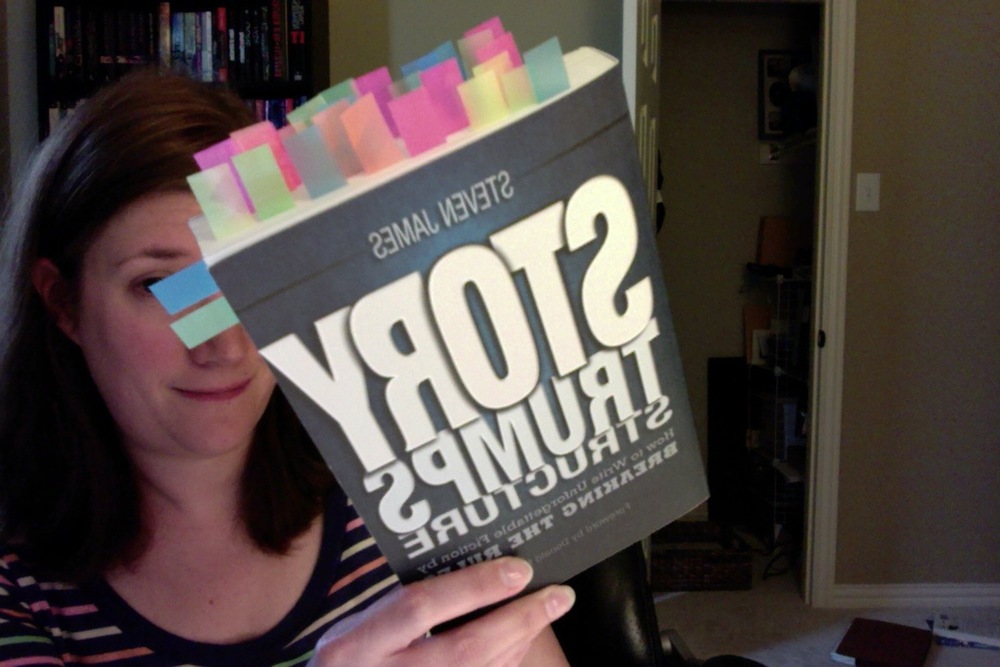
*I put a sticky tab on any page with a point I wanted to type into my notes. Look at that rainbow, people.
I know I usually tackle fiction when doing a Must Read Monday, but I read a writing craft book this weekend that was just so fabulous that I wanted to pass it along to those of you who are writers.
As most of you know, I'm a bit addicted to reading books about the craft of writing. (Yes, I'm an unrepentant nerd.) But most of the time, those books are all about different ways to plot your book. And I like learning those techniques because I'm a pantser with plotter envy. Writing without an outline can be an anxiety-ridden process, writer's block can pop up often, and the unknown is freaking scary (especially when you're writing under a deadline.) But no matter how hard I've tried to alter my process, I can't seem to get away from my pantsing (writing by the seat of my pants) ways.
And a little part of me has always been afraid that if I was successful at plotting ahead and outlining that I would lose some of the "magic" of my writing process. Like two weeks ago, this happened when I was happily writing a story. I had a general direction in mind and then got hit with a big twist that I had never ever considered or planned. It changes what the rest of the book will look like, but I think it's the correct (and much more interesting) way to go. If I had been writing to an outline, would that had ever come to me? And if it had, would I have been willing to ditch the whole second half of the outline to go in this new direction?
That kind of "a-ha" discovery happens with every book. The big twist in Crash Into You that most people have told me they never saw coming? That was because *I* didn't know it was coming until I was 70% of the way through writing the book. The big thing that happens in Kade's backstory in Need You Tonight that explains so much about who he is now? I didn't know about it until I was halfway through the book and it hit me--wait, THAT'S what happened!
So let me tell you, it was hella refreshing to finally come across a book that doesn't just tolerate pantsing as a way for people to write but actually recommends it. AND gives tips on how to overcome some of the struggles, anxieties and pitfalls of writing without an outline. Because, Lord, I would love to be less neurotic during my writing process.
So here's the book and my review from Goodreads. Pantsers, go forth and enjoy!
Story Trumps Structure: How to Write Unforgettable Fiction by Breaking the Rules by Steven James
My Review from Goodreads:
Finally, a book for pantsers! And not just one that mentions pantsing but validates the process as a legitimate (he even ventures to say superior) process of writing. I have long been a pantser with plotter envy because it seems like every book on writing I read talks about "organic" writing as the immature/impatient process and plotting as the panacea, the "professional" way. Of course, that always makes plotting sound like this lovely method that is going to take away the constant anxiety of working in the unknown and the pitfalls that come along with that (writer's block, chasing bunny trails, rereading your previous pages constantly to get back into the mindset, etc.). But after reading this, I feel like I can take a deep breath and find a place of acceptance with my pantsing ways. Yes, my method causes me anxiety, but it's also been a successful one for me, so why am I always trying to change it?
And with this book, there are methods that may even help with the anxiety involved in "flying into the mist" when writing. There are questions to ask when you get stuck or come across a plot problem. There are guidelines on what needs to be clear in each scene and how to keep the tension up. There are pointers on how to include twists. And some of the character stuff--questions to ask about their secrets, shame, fears, etc--was brilliant.
I have five pages of notes from the book and put sticky flags on way too many pages because there was too much great stuff to hold in my head all at once. I'm kind of a junkie when it comes to book on writing and can be hard to please, but I have no qualms giving this one five stars. I know I'll be referencing it often.
*I was not asked to give this review. I bought this book on my own.

